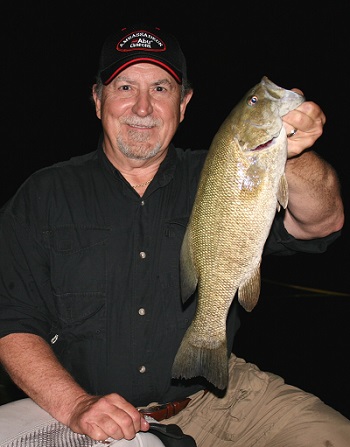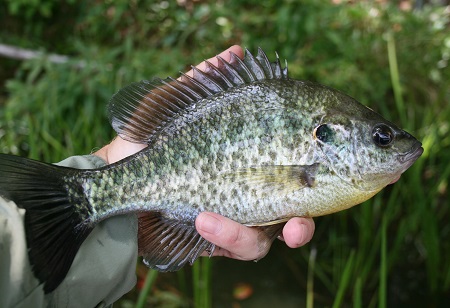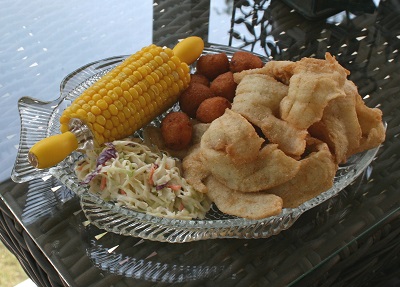Weekend Angler: Hot Summertime Fun
By D. Keith Bartlett on July 19, 2014 from Weekend Angler via Connect-Bridgeport.com
 As a longtime outdoors person, there’s one thing I’ve noticed through the years; when winter is long and cold with above-average snow, spring is often short and hot. I had barely recovered from the last snowstorm when air temperatures shot into the eighties and stayed there. I continued to carry cold-weather clothing in my new boat-hauling vehicle until it became obvious it was no longer needed. I had to laugh while unloading a goose-down jacket from the back one morning in shorts, no shirt and bare feet. The hot weather was welcome until it became apparent that area water temperatures were climbing quickly and seasonal rainfall had disappeared with the lower temperatures. Furthermore, local dams had been forced to reduce water generation to allow upstream lakes to reach summer pool, which meant extended periods of no flow in tail-waters and reduced flow in some rivers. After realizing it was going to be a short, hot and dry spring the rush was on to enjoy the remaining good spring fishing while it lasted.
As a longtime outdoors person, there’s one thing I’ve noticed through the years; when winter is long and cold with above-average snow, spring is often short and hot. I had barely recovered from the last snowstorm when air temperatures shot into the eighties and stayed there. I continued to carry cold-weather clothing in my new boat-hauling vehicle until it became obvious it was no longer needed. I had to laugh while unloading a goose-down jacket from the back one morning in shorts, no shirt and bare feet. The hot weather was welcome until it became apparent that area water temperatures were climbing quickly and seasonal rainfall had disappeared with the lower temperatures. Furthermore, local dams had been forced to reduce water generation to allow upstream lakes to reach summer pool, which meant extended periods of no flow in tail-waters and reduced flow in some rivers. After realizing it was going to be a short, hot and dry spring the rush was on to enjoy the remaining good spring fishing while it lasted.
Good spring trout fishing was the first to diminish. With reduced water flow, my favorite area tail-water soon warmed to temperatures above the trout’s preferred range and my best trophy-trout river became so shallow it could no longer be fished from a boat. My friends and I continued to catch some good trout by moving downstream toward reservoir headwaters into deeper, cooler water, though the average size and number of fish we caught was less than normal. We missed the extended period of fine spring trout fishing this year and the great night fishing for shallow-water hybrids was equally short. After several successful trips, lake surface temperatures moved into the low- to mid-80’s and larger hybrids retreated from the shallows. On our last trip to fish for them we found a few fish breaking and threw everything we had at them before finally catching one that barely stretched to the fifteen-inch minimum legal size. After that fruitless night, the spring hybrid blitz was over. Hybrids are one of my favorite fish, to catch and to eat, so I was disappointed that the best shallow-water fishing for them was over for the year. Little did I know; it wasn’t the last I’d see of Mr. Hybrid.
A few weeks later, we went to a local highland reservoir on our first trip of the season to fish at night for smallmouth bass. At the first place we stopped, we found a young couple stranded in a broken-down pontoon boat in the back of a small cove. After a long, slow tow to the closest marina and safety, we returned to our starting point and started fishing. On my second or third cast into the darkness with a tiny jig and 4-pound diameter line, a gorilla of a fish grabbed my lure and bent my rod in half. I struggled to loosen my drag while the monster headed for deep water, ripping line from my reel. I was sure I’d hooked the smallmouth bass of my dreams. After a long, exciting fight, my fishing partner netted the beast in the dim light and we could see the profile of a huge fish struggling in the net; it was Moby Smallmouth. When we turned on a flashlight to admire the fish, shock struck both of us. It was an eight-plus-pound hybrid striped bass; from a lake that has never been stocked with hybrids or striped bass. What are the odds of that?! We could not believe it was a hybrid. After regaining my composure, I decided that fish was a gift, a reward for rescuing the young couple from a long dark night on the lake or compensation for the shortened spring hybrid fishing. I was not sure which but was no less thankful for catching it and decided to make it my last grilled hybrid of the season. My policy is: Don’t insult the giver by not accepting and appreciating a gift. That experience, and the marvelous meals that followed, marked the end of my transition into summer fishing mode.
Good summer night-fishing for smallmouth bass in reservoirs is now underway. I’ve made several trips to fish for them and enjoyed success. Surface water temperatures in most area reservoirs are well into the eighties and the bass are staged on normal summer structures and feeding heavily at night, though most are holding deeper than normal. In early summer, it’s common to find smallmouths holding and active between twelve- and eighteen-feet. Most nights this is the range where you can find and catch many fish. However, it’s not uncommon to catch smaller fish in shallower water, or an occasional larger one that has moved shallow to feed, but twelve- to eighteen-feet is a reliably productive range. When fishing this depth range, it’s best to hold the boat over thirty-feet or a little deeper water. With higher surface temperatures this season, the best action has been between eighteen- and twenty-five feet. Again, we’ve caught some bass shallower including a few nice ones, but most fish caught and all the larger smallmouths have been hooked at twenty-feet or a little deeper. To fish this range without moving on top of the bass we’ve changed our holding depth to between thirty-five- and forty-feet deep. To the inexperienced, this may sound like a complicated way to fish and difficult to learn, but it’s not. It’s a productive way to catch smallmouth bass throughout summer when boat traffic and fishing pressure are lowest and the fish are active and feeding. For a complete guide on finding and catching them at night on reservoirs including the approach tackle, and lures I use, refer to the chapter on summer fishing in my book, The weekend Angler's
 Guide To Good Fishing.
Guide To Good Fishing.
One of my goals this year is to spend more time fishing for panfish. Last fall I found a tiny lake in the mountains of Southwest Virginia with a reputation for producing good bluegills and shellcrackers so when the weather began warming I bought a Virginia fishing license, inventoried and added a few items to my bream fishing toolbox, confirmed a reliable source for buying crickets and started watching the Moon phase and weather forecast. This little lake is the kind of small waters to search for when targeting larger bream and largemouth bass. It’s less than one-hundred acres, has several fresh water sources,
a good mixture of deep versus shallow water, and a balanced population of panfish in various age classes including trophies. To add to the lake’s potential, gasoline-powered motors are not permitted and much of it is covered with flooded timber, making boat navigation hazardous. These features help reduce fishing pressure. A combination of thunderstorms and high winds kept me off the water during the first major spawning period of early summer but the next full moon arrived with a free morning when the probability of thunderstorms was low enough to warrant an exploratory trip. In a half day, I fished about a third of the lake and did find a few spawning beds; difficult because the water was heavily stained. The lake’s dark, tannic water reminds me of those in Ontario but recent heavy rains had dropped water clarity to almost zero. Many smaller fish were caught that first morning but several large bluegills and one nice shellcracker were included in the catch. It was enough to whet my appetite so I began making plans for a full day of fishing, despite Moon phase, as soon as my schedule and the weather forecast permitted.
It was a partly cloudy, hot, muggy morning the day before a new moon when I next launched my boat on my newest fishing hotspot. Because the fish would not be on spawning beds, I’d rigged several ultralight spinning combos to help me find and catch fish. With a few crickets on hand, one was filled with fluorescent braided line and a six-pound fluorocarbon leader tipped with a small hook and split shot to present them along bottom. I also brought several tiny spoons to fish with this combo and quickly cover various bottoms depths, if needed. A second combo was set up with a drop-shot rig to present tiny one-inch Gulp Minnows a foot or more off bottom after finding concentrations of fish. A third combo was rigged with a fluorescent monofilament mainline, a six-pound fluorocarbon leader and a tiny snap for presenting small lures horizontally and closer to the surface. I had done more homework since my first visit and found a map of the lake on the Internet showing the maximum water depth and what sections held the deepest water. On my first trip, I hadn’t gone far enough out on the lake to reach the deepest water but this time went there first. When water temperature peaks in summer, many fish move to areas close to deep water so my plan was to begin fishing shorelines close to the deepest water in the lake. I moved to a point leading into a large lake arm where depth was greatest, slowed my trolling motor speed and began watching my depth finder as the boat eased along the edge of a wall of weed growth that extended several feet off shore. My first objective was to find fish and determine the depth at which they were most concentrated.
The weed edge along shore varied in width and density depending on changes in bottom depth but created a vertical wall that ended abruptly at five-feet deep. Water depth outside but close to the edge varied from seven-feet to around twelve-feet. Moving far out into the lake wasn’t wise because the middle of the lake arm was full of protruding dead trees and stumps hidden just below the water’s surface. I soon learned to watch carefully and move about slowly because my boat struck hidden stumps several times. Once, after becoming a little overanxious, the boat hung securely on top of a big stump and I briefly thought swimming might be the only way to free it. But other than where a couple trees had fallen, there was an open boat lane for a long way close to shore. Before moving far, suspended fish appeared on the depth finder between three- and about five-feet deep so I quietly turned the boat, moved offshore as far as possible without crashing into wood and returned to my starting point. The boat lane continued for several hundred yards so I decided to troll a minnow imitation along the weed edge and continue the search. I’d brought several small hard-baits from my trout toolbox and chose a tiny crankbait with a green back, white belly and diving lip that would take the lure to the correct range of depths. It was a good choice because that one lure caught fish almost nonstop the rest of the day.
I trolled along shore with a single rod and reel until water became too shallow or flooded wood created a barrier. Where forward movement was blocked, I reeled in the lure, moved around the obstacle or turned and began trolling back along the same path. Trolling along at a slow, steady pace of about one mph worked surprisingly well when action was added to the presentation by pulling the lure forward, then dropping line back until the lure slowed or stopped. Twitching the lure erratically produced similar results. I had many strikes doing this and soon learned not to set the hook until a fish pulled a bend in the rod. It was entertaining to troll along, suddenly see suspended fish on the depth finder, feel them begin striking at the plug and finally see the rod bend under the weight of a fish. Multiple thumps on the lure before hookups were common. Larger bream are determined fighters and test an angler’s fighting skill on light tackle in cover. After several fish pulled free, including a couple jumbos, I decided the hooks on my crankbait were too small to hold harder pulling fish so I paused for a few minutes to inspect my newest fishing tool. I’d brought four of these diminutive crankbaits in various colors, all the same length at one-and-a-quarter inches, and each with a tiny set of size 14 treble hooks. After a close inspection of each, I found the lure's name on the bill of one: Ugly Duckling. I recognized the name but couldn’t remember buying or ever fishing with them.
 But I vowed to find and buy a couple more in brighter colors because they’re impressively effective fishing tools for panfish, run true, adjust easily when they don’t, produce a lively throbbing action, and have nice paint jobs. After studying the lure, I upsized the rear treble to a size 12 and didn’t lose another fish the rest of the day. The change made the hooks more likely to tangle but it was a minor inconvenience while trolling with a short line. Furthermore, the added weight caused the Ugly Duckling to suspend right under the surface instead of float though the change didn’t alter the lures action or running depth much because bluegills, shellcrackers and crappie attacked it equally well after the rear hook was changed.
But I vowed to find and buy a couple more in brighter colors because they’re impressively effective fishing tools for panfish, run true, adjust easily when they don’t, produce a lively throbbing action, and have nice paint jobs. After studying the lure, I upsized the rear treble to a size 12 and didn’t lose another fish the rest of the day. The change made the hooks more likely to tangle but it was a minor inconvenience while trolling with a short line. Furthermore, the added weight caused the Ugly Duckling to suspend right under the surface instead of float though the change didn’t alter the lures action or running depth much because bluegills, shellcrackers and crappie attacked it equally well after the rear hook was changed.
I spent most of the day trolling the Ugly Duckling, including a second color, but stopped occasionally where fish were most concentrated to present Gulp Minnows on a drop-shot rig. Where fish were holding closer to bottom, the drop-shot rig attracted strikes and produced some of my largest bluegills of the day. However, it was difficult to stop trolling when the fish were whacking those tiny crankbaits so well. A variety of mini crankbaits and minnows are available for panfish anglers today including those made by Rapala, Rebel, Yo-Zuri, and others. If you decide to try trolling for bream this summer on your home waters, choose two or three brands of hard baits that run at various depths in natural colors for clear conditions, brighter patterns for periods of low visibility and make sure each is well tuned and runs true. Then, go take a drive along shore close to deep water where dense cover or weed growth attracts panfish. I’m going to spend more time fishing for these wonderful fish this summer after finding a beautiful place that offers good fishing for them. Next trip, I’ll take along some slip bobber rigs, small jigs and other tools to continue my search for trophies and more fresh-fish dinners. Bream are fun to catch on ultralight tackle and delicious deep fried. But if you find a special place with a good population of larger fish, keep midsize and smaller fish for the table and release the largest to conserve the resource and support continued good fishing.
Editor's Note: Bartlett, a 1971 graduate of Bridgeport High School, is a published author with the book “The Weekend Angler’s Guide to Good Fishing.” The book is available for purchase at The Country Peddler in Bridgeport. Follow his fishing exploits on his Blog at http://theweekendanglersguidetogoodfishing.wordpress.com/or contact him at theweekendangler1@gmail.com.

